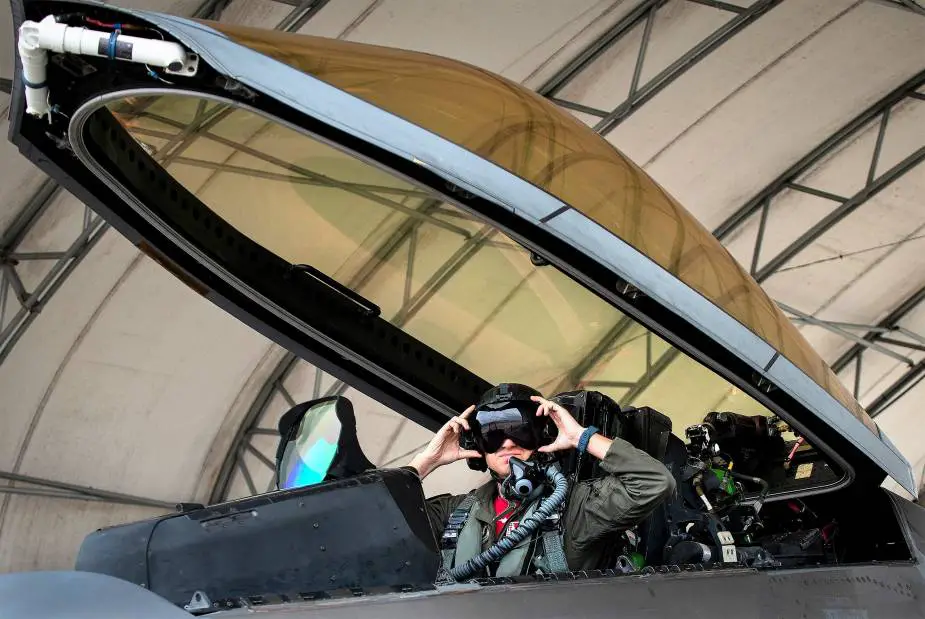Breaking news
US Air Force F-22A Raptor pilots test next-gen helmet.
U.S. engineers with the 46th Test Squadron and the 28th Test and Evaluation Squadron oversee the helmet testing. Approximately five F-22A Raptor pilots from the 301st Fighter Squadron, a Reserve unit with the 43rd Fighter Squadron at Eglin AFB, fly with the new lighter, cooler and more readily-equipped helmet. Samuel King Jr., Eglin Air Force Base Public Affairs, reports.
Follow Air Recognition on Google News at this link
 Maj. Brett Gedman, 301st Fighter Squadron, brings down the Next Generation Fixed Wing Helmet’s visor prior to an F-22A Raptor mission on March 24, 2023, at Eglin Air Force Base, Fla. These tests mark the second round of developmental testing since the Air Force announced the new LIFT-manufactured helmet in 2022 (Picture source: U.S. Air Force/Samuel King Jr.)
Maj. Brett Gedman, 301st Fighter Squadron, brings down the Next Generation Fixed Wing Helmet’s visor prior to an F-22A Raptor mission on March 24, 2023, at Eglin Air Force Base, Fla. These tests mark the second round of developmental testing since the Air Force announced the new LIFT-manufactured helmet in 2022 (Picture source: U.S. Air Force/Samuel King Jr.)
The NGFWH (Next Generation Fixed Wing-Helmet) program goal is to provide pilots with a more comfortable, stable and balanced platform to accommodate helmet-mounted device usage without imposing neck strain and discomfort on the user. “It is common knowledge fighter pilots have long-term neck and back issues,” said Maj. Brett Gedman, 301st FS pilot. “Therefore, having a lightweight helmet designed with the operator in mind will have positive long-term impacts on the health of our fighter pilots during and after service.”
This series of tests marks the second round of developmental tests with the LIFT Airborne Technologies-manufactured helmet since it was awarded the contract in 2022. The NGFWH is set to replace the more than the 40-year-old current model, known as HGU-55, used by all Air Force aircrew except F-35 Lightning II flyers.
After each flight, the pilots report any feedback they have about wearability, visibility, communication, etc. The engineers compile that data to provide to the manufacturers. So far, outside of minor tweaks, the feedback is positive. “The design of the helmet allows for unparalleled visibility, mobility and comfort in the cockpit,” Gedman said. “The increased visibility combined with the mobility it provides made it a massive improvement over what I am used to flying with. It is clear this has been a generational leap in technology that the fighter pilot deserves, which is long overdue.”
Gedman said those factors are critical when operating in a high-G within visual range environment: “With near-peer threats narrowing the gap daily, it is critical the fighter pilots have every tactical advantage possible,” Gedman said. “Details matter and it is coming down to the smallest details including the gear we wear.”
Along with Air Force aircrew, the new helmet also has a great effect on aircrew flight equipment technicians. They are responsible for preparing, equipping and maintaining the helmets for the aircrew.
Many flight advancements are now standard on the new helmet such as night-vision goggle mounts and an adjustable occipital basket. With the legacy helmet, HGU-55, these items are added manually, adjusted and fitted to the aircrew and take hours to prepare. To add an NVG mount to the legacy helmet, an AFE Airman uses power tools to drill into the helmet to secure the bracket.
“From a pre-flight and build-up standpoint, the new helmet is much better,” said Airman 1st Class Matthew Crouse, a 325th Operations Support Squadron AFE technician responsible for NGFWH maintenance during the testing. “It makes our job much easier in the long run, but because it’s so easy to adjust, we can make corrections if they are needed.”
When the F-22 squadrons leave Eglin AFB soon for Joint Base Langley-Eustis, Virginia, the test engineers will follow for a new round of testing with new pilots. Eventually, the tests will spread out to other aircraft and aircrew. The next aircraft type scheduled to test the helmets will be the HC-130J Combat King II and B-1B Lancer.
 The Air Force’s Next Generation Fixed Wing Helmet sits ready for testing at Eglin Air Force Base, Fla. The 46th Test Squadron engineers have begun developmental testing on NGFWH with F-22 pilots while the aircraft are stationed at Eglin AFB (Picture source: U.S. Air Force/Samuel King Jr.)
The Air Force’s Next Generation Fixed Wing Helmet sits ready for testing at Eglin Air Force Base, Fla. The 46th Test Squadron engineers have begun developmental testing on NGFWH with F-22 pilots while the aircraft are stationed at Eglin AFB (Picture source: U.S. Air Force/Samuel King Jr.)


























